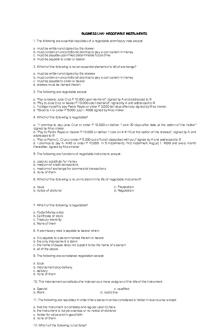MCQ with answers PDF

| Title | MCQ with answers |
|---|---|
| Course | Principles Of Management |
| Institution | Panjab University |
| Pages | 4 |
| File Size | 49.8 KB |
| File Type | |
| Total Downloads | 91 |
| Total Views | 161 |
Summary
10 MCQ with answers...
Description
1. The process of dividing the large monolithic functional organization into small and flexible administrative units is called ____. A. staffing. B. delegation. C. departmentation. D. control. ANSWER: C 2. Departmentation is a part of the ___. A. organisation process. B. control process. C. planning process. D. staffing process. ANSWER: A 3. Banks, insurance companies and distribution agencies are examples of ____. A. departmentation by function. B. departmentation by-products. C. departmentation by territory. D. departmentation by customers. ANSWER: C 4. Departmentation on the basis of the production process is called ____.
A. equipment department. B. departmentation by-products. C. departmentation by territory. D. departmentation by customers. ANSWER: A 5. The term span of management is also known as ____. A. span of the business. B. span of control. C. span of activity. D. span of planning. ANSWER: B 6. The orders, instructions or directions are delegated to a particular person specifically is known as ____. A. general delegation. B. formal delegation. C. specific delegation. D. informal delegation. ANSWER: C 7. When authority is delegated as per the organisation structure it is called ____. A. formal delegation.
B. informal delegation. C. general delegation. D. specific delegation. ANSWER: A 8. When an individual or a group agrees to work under the direction of an informal leader is called _____. A. formal delegation. B. informal delegation. C. general delegation. D. specific delegation. ANSWER: B 9. Delegation made by written orders and instruction is known as ____. A. oral delegation. B. written delegation. C. downward delegation. D. sideward delegation. ANSWER: B 10. Departmentation on the basis of activities grouped according to the type of customer is _____. A. departmentation by function.
B. departmentation by-products. C. departmentation by territory. D. departmentation by customers. ANSWER: D...
Similar Free PDFs

MCQ Practice with Answers
- 39 Pages

Land MCQ with Answers
- 4 Pages

MCQ with answers
- 4 Pages

Money Market MCQ with Answers
- 3 Pages

5.1 MCQ Answers - fdsfa
- 2 Pages

Week3 MCQ Answers
- 14 Pages
Popular Institutions
- Tinajero National High School - Annex
- Politeknik Caltex Riau
- Yokohama City University
- SGT University
- University of Al-Qadisiyah
- Divine Word College of Vigan
- Techniek College Rotterdam
- Universidade de Santiago
- Universiti Teknologi MARA Cawangan Johor Kampus Pasir Gudang
- Poltekkes Kemenkes Yogyakarta
- Baguio City National High School
- Colegio san marcos
- preparatoria uno
- Centro de Bachillerato Tecnológico Industrial y de Servicios No. 107
- Dalian Maritime University
- Quang Trung Secondary School
- Colegio Tecnológico en Informática
- Corporación Regional de Educación Superior
- Grupo CEDVA
- Dar Al Uloom University
- Centro de Estudios Preuniversitarios de la Universidad Nacional de Ingeniería
- 上智大学
- Aakash International School, Nuna Majara
- San Felipe Neri Catholic School
- Kang Chiao International School - New Taipei City
- Misamis Occidental National High School
- Institución Educativa Escuela Normal Juan Ladrilleros
- Kolehiyo ng Pantukan
- Batanes State College
- Instituto Continental
- Sekolah Menengah Kejuruan Kesehatan Kaltara (Tarakan)
- Colegio de La Inmaculada Concepcion - Cebu









